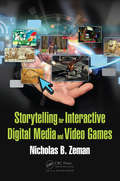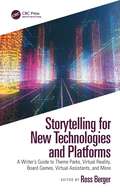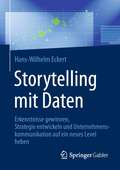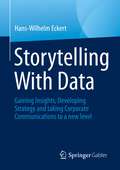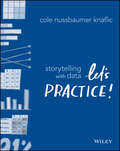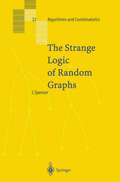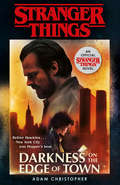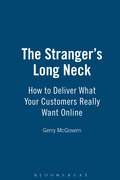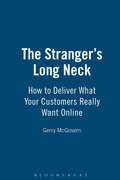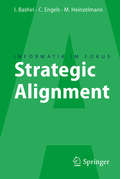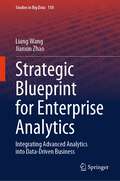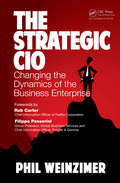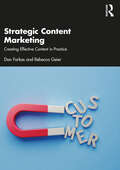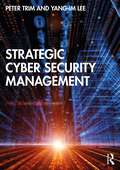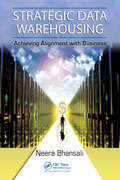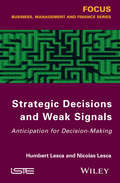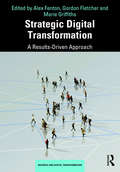- Table View
- List View
Storytelling for Interactive Digital Media and Video Games
by Nicholas B. ZemanThe evolution of story-telling is as old as the human race; from the beginning, when our ancestors first gathered around a campfire to share wondrous tales through oral traditions, to today, with information and stories being shared through waves and filling screens with words and images. Stories have always surrounded us, and united us in ways other disciplines can't. Storytelling for Interactive Digital Media and Video Games lays out the construct of the story, and how it can be manipulated by the storyteller through sound, video, lighting, graphics, and color. This book is the perfect guide to aspiring storytellers as it illustrates the different manner of how and why stories are told, and how to make them "interactive." Storytelling features heavy game development as a method of storytelling and delivery, and how to develop compelling plots, characters, settings, and actions inside a game. The concept of digital storytelling will be explored, and how this differs from previous incarnations of mediums for stories Key Features: Explores the necessary elements of a story (setting, character, events, sequence, and perspective) and how they affect the viewer of the story Discusses media and its role in storytelling, including images, art, sound, video, and animation Explores the effect of interactivity on the story, such as contest TV, web-based storytelling, kiosks, and games Shows the different types of story themes in gaming and how they are interwoven Describes how to make games engaging and rewarding intrinsically and extrinsically
Storytelling for New Technologies and Platforms: A Writer’s Guide to Theme Parks, Virtual Reality, Board Games, Virtual Assistants, and More
by Ross BergerWant to know what it’s like to write for a theme park attraction? Or an interactive toy? Or for a virtual reality game? Wait – those tell stories? And there are jobs for people to write them? Thanks to technology, interactive products and live experiences can now engage us with memorable characters and exciting adventures that were once only destined for the cinema. Storytelling for New Technologies and Platforms: A Writer’s Guide to Theme Parks, Virtual Reality, Board Games, Virtual Assistants, and More is a handbook for writers, students, producers, teachers, scholars, career changers, early tech adopters, and just about anyone who loves story and technology. As a collection of articles from some of the best creative writers in their medium, this book will prepare content creators of tomorrow to tackle some of today's most exhilarating creative challenges found on a screen ... or off! Key Features: Expert advice from several industry professionals who have worked for some of the world’s biggest tech and interactive companies. Best practices that not only guide writers on how to apply their craft to new fields, but also prepare them for the common ambiguity they will find in corporate and start-up environments. Breakdown of platforms that shows how tech capabilities can fulfill content expectations and how content can fulfill tech expectations. Basic storytelling mechanics customized to today’s popular technologies, live experiences, and traditional game platforms.
Storytelling for New Technologies and Platforms: A Writer’s Guide to Theme Parks, Virtual Reality, Board Games, Virtual Assistants, and More
by Ross BergerWant to know what it’s like to write for a theme park attraction? Or an interactive toy? Or for a virtual reality game? Wait – those tell stories? And there are jobs for people to write them? Thanks to technology, interactive products and live experiences can now engage us with memorable characters and exciting adventures that were once only destined for the cinema. Storytelling for New Technologies and Platforms: A Writer’s Guide to Theme Parks, Virtual Reality, Board Games, Virtual Assistants, and More is a handbook for writers, students, producers, teachers, scholars, career changers, early tech adopters, and just about anyone who loves story and technology. As a collection of articles from some of the best creative writers in their medium, this book will prepare content creators of tomorrow to tackle some of today's most exhilarating creative challenges found on a screen ... or off! Key Features: Expert advice from several industry professionals who have worked for some of the world’s biggest tech and interactive companies. Best practices that not only guide writers on how to apply their craft to new fields, but also prepare them for the common ambiguity they will find in corporate and start-up environments. Breakdown of platforms that shows how tech capabilities can fulfill content expectations and how content can fulfill tech expectations. Basic storytelling mechanics customized to today’s popular technologies, live experiences, and traditional game platforms.
Storytelling mit Daten: Erkenntnisse gewinnen, Strategie entwickeln und Unternehmenskommunikation auf ein neues Level heben
by Hans-Wilhelm EckertDieses Buch zeigt, welche Rolle Daten für Kommunikation und Marketing spielen und wie sie als wichtige Quelle für das Storytelling genutzt werden können. Denn Daten beflügeln als Rohstoff des digitalen Zeitalters die Unternehmensstrategie. Sie ermöglichen – sofern sauber gesammelt, interpretiert und aufbereitet – neue und mitunter überraschende Einblicke in Zusammenhänge und bieten die Chance, daraus spannende Geschichten zu entwickeln. Geschichten, die auch im Hinblick auf Unternehmensziele Relevanz schaffen, Dialoge entfachen und die Kommunikation wirksam machen. Der Autor erklärt auf leicht verständliche Art und Weise, wie sich datenbasierte Kommunikationsstrategien in packende Storys verwandeln lassen. Zudem liefert er nützliche Tools und zeigt auf, warum Daten lügen können, wie wichtig ihre optische Aufbereitung ist, wo ihr Einsatz an ethische Grenzen stößt und warum Datenschutz auch eine unternehmerische Chance ist. Anhand von praktischen Beispielen bietet das Buch Marketing- und Kommunikationsexperten – aber auch interessierten Managern aus anderen Disziplinen – zahlreiche Inspirationen und neue Perspektiven.
Storytelling With Data: Gaining Insights, Developing Strategy and taking Corporate Communications to a new level
by Hans-Wilhelm EckertThis book shows the role data plays in communication and marketing and how it can be used as an important source for storytelling. Because data, as a raw material of the digital age, inspires corporate strategy. Provided it is collected, interpreted and processed properly, it provides new and sometimes surprising insights into contexts and offers the opportunity to develop exciting stories from it. Stories that also create relevance with regard to corporate goals, spark dialogues and make communication effective. The author explains in an easy-to-understand way how data-based communication strategies can be turned into gripping stories. He also provides useful tools and shows why data can lie, how important its visual processing is, where its use meets ethical limits and why data protection is also a business opportunity. Using practical examples, the book offers marketing and communication experts - but also interested managers from other disciplines - numerous inspirations and new perspectives.
Storytelling with Data: Let's Practice!
by Cole Nussbaumer KnaflicInfluence action through data! This is not a book. It is a one-of-a-kind immersive learning experience through which you can become—or teach others to be—a powerful data storyteller. Let’s practice! helps you build confidence and credibility to create graphs and visualizations that make sense and weave them into action-inspiring stories. Expanding upon best seller storytelling with data’s foundational lessons, Let’s practice! delivers fresh content, a plethora of new examples, and over 100 hands-on exercises. Author and data storytelling maven Cole Nussbaumer Knaflic guides you along the path to hone core skills and become a well-practiced data communicator. Each chapter includes: ● Practice with Cole: exercises based on real-world examples first posed for you to consider and solve, followed by detailed step-by-step illustration and explanation ● Practice on your own: thought-provoking questions and even more exercises to be assigned or worked through individually, without prescribed solutions ● Practice at work: practical guidance and hands-on exercises for applying storytelling with data lessons on the job, including instruction on when and how to solicit useful feedback and refine for greater impact The lessons and exercises found within this comprehensive guide will empower you to master—or develop in others—data storytelling skills and transition your work from acceptable to exceptional. By investing in these skills for ourselves and our teams, we can all tell inspiring and influential data stories!
Storytelling with Data: Let's Practice!
by Cole Nussbaumer KnaflicInfluence action through data! This is not a book. It is a one-of-a-kind immersive learning experience through which you can become—or teach others to be—a powerful data storyteller. Let’s practice! helps you build confidence and credibility to create graphs and visualizations that make sense and weave them into action-inspiring stories. Expanding upon best seller storytelling with data’s foundational lessons, Let’s practice! delivers fresh content, a plethora of new examples, and over 100 hands-on exercises. Author and data storytelling maven Cole Nussbaumer Knaflic guides you along the path to hone core skills and become a well-practiced data communicator. Each chapter includes: ● Practice with Cole: exercises based on real-world examples first posed for you to consider and solve, followed by detailed step-by-step illustration and explanation ● Practice on your own: thought-provoking questions and even more exercises to be assigned or worked through individually, without prescribed solutions ● Practice at work: practical guidance and hands-on exercises for applying storytelling with data lessons on the job, including instruction on when and how to solicit useful feedback and refine for greater impact The lessons and exercises found within this comprehensive guide will empower you to master—or develop in others—data storytelling skills and transition your work from acceptable to exceptional. By investing in these skills for ourselves and our teams, we can all tell inspiring and influential data stories!
Strahlentherapie atmungsbewegter Tumoren: Bewegungsfeldschätzung und Dosisakkumulation anhand von 4D-Bilddaten (Aktuelle Forschung Medizintechnik – Latest Research in Medical Engineering)
by René WernerAtmungsbedingte Bewegungen stellen eine zentrale Herausforderung in der Strahlentherapie dar. Als Grundlage der Berücksichtigung von Atembewegungen während der Therapie kommen zunehmend Verfahren zur 4D(=3D+t)-CT-Bildgebung zum Einsatz. Deren Integration in den klinischen Workflow bedarf aus Sicht der Bildverarbeitung zweier zentraler Schritte: einer bildbasierten Abschätzung der Organ- und Tumorbewegungen sowie der Berücksichtigung der geschätzten Bewegungen während der Dosisberechnung im Sinne einer Dosisakkumulation. Unter Rückgriff auf Verfahren zur nicht-linearen Registrierung entwickelt, evaluiert und optimiert René Werner zunächst Ansätze zur patientenspezifischen Bewegungsfeldschätzung und statistischen Bewegungsmodellierung. Hierauf aufbauend leitet er Schemata für eine präzise Dosisakkumulation her und setzt diese zur Untersuchung der Auswirkungen atmungsbedingter Bewegungen in der Strahlentherapie von Lungentumoren ein.
The Strange Logic of Random Graphs (Algorithms and Combinatorics #22)
by Joel SpencerThe study of random graphs was begun in the 1960s and now has a comprehensive literature. This excellent book by one of the top researchers in the field now joins the study of random graphs (and other random discrete objects) with mathematical logic. The methodologies involve probability, discrete structures and logic, with an emphasis on discrete structures.
Stranger Things: The Second Official Novel (Stranger Things Ser.)
by Adam ChristopherChief Jim Hopper reveals long-awaited secrets to Eleven about his old life as a police detective in New York City, confronting his past before the events of the hit show Stranger Things. Christmas, Hawkins, 1984. All Chief Jim Hopper wants is to enjoy a quiet first Christmas with Eleven, but his adopted daughter has other plans. Over Hopper’s protests, she pulls a cardboard box marked “New York” out of the basement—and the tough questions begin. Why did Hopper leave Hawkins all those years ago? What does “Vietnam” mean? And why has he never talked about New York?Although he’d rather face a horde of demogorgons than talk about his own past, Hopper knows that he can’t deny the truth any longer. And so begins the story of the incident in New York—the last big case before everything changed…Summer, New York City, 1977. Hopper is starting over after returning home from Vietnam. A young daughter, a caring wife, and a new beat as an NYPD detective make it easy to slip back into life as a civilian. But after shadowy federal agents suddenly show and seize the files about a series of brutal, unsolved murders, Hopper takes matters into his own hands, risking everything to discover the truth.Soon Hopper is undercover among New York’s notorious street gangs. But just as he's about to crack the case, a blackout rolls across the boroughs, plunging Hopper into a darkness deeper than any he’s faced before.
The Stranger's Long Neck: How to Deliver What Your Customers Really Want Online
by Gerry McGovernThe Stranger's Long Neck is a practical guide for any manager wishing to improve their organisation's online performance. Web content specialist, Gerry McGovern, explains that all websites have a small set of tasks, or 'long necks', that are important to its customers and that must be easy to complete or customers will go elsewhere. The Stranger's Long Neck shows how to tune in effectively to what your customers want - and then deliver it with aplomb.Understanding customer needs can be a difficult task when customers are 'strangers', in that he or she is always 'on the outside', particularly so in an online environment. Using case studies including Tetra Pak, Microsoft and the NHS, and illustrated with web shots throughout, The Stranger's Long Neck shows organisations are able to use the 'long neck' theory to create and manage efficient and user-friendly websites.
The Stranger's Long Neck: How to Deliver What Your Customers Really Want Online
by Gerry McGovernThe Stranger's Long Neck is a practical guide for any manager wishing to improve their organisation's online performance. Web content specialist, Gerry McGovern, explains that all websites have a small set of tasks, or 'long necks', that are important to its customers and that must be easy to complete or customers will go elsewhere. The Stranger's Long Neck shows how to tune in effectively to what your customers want - and then deliver it with aplomb.Understanding customer needs can be a difficult task when customers are 'strangers', in that he or she is always 'on the outside', particularly so in an online environment. Using case studies including Tetra Pak, Microsoft and the NHS, and illustrated with web shots throughout, The Stranger's Long Neck shows how organisations can use the 'long neck' theory to create and manage efficient and user-friendly websites.
Strategic Alignment: Zur Ausrichtung von Business, IT und Business Intelligence (Informatik im Fokus)
by Iman Bashiri Christoph Engels Marcus HeinzelmannVielen Unternehmen gelingt es nicht, ein anhaltendes Alignment in ihrer Organisation zu etablieren. Dabei kommt dem Strategic Alignment für die Schaffung von Wettbewerbsvorteilen und die Steigerung der Performance eine Schlüsselrolle zu. Beginnend mit einer Beschreibung des strategischen Alignments auf dem neuesten wissenschaftlichen Stand, entwickeln die Autoren ein ganzheitliches Vorgehensmodell, das auf erprobten Instrumenten und methodischen Ansätzen beruht. Der Band enthält drei Fallstudien zu Marriott International, Capital One und Volkswagen.
Strategic Blueprint for Enterprise Analytics: Integrating Advanced Analytics into Data-Driven Business (Studies in Big Data #150)
by Liang Wang Jianxin ZhaoThis book is a comprehensive guide for professionals, leaders, and academics seeking to unlock the power of data and analytics in the modern business landscape. It delves deeply into the strategic, architectural, and managerial aspects of implementing enterprise analytics (EA) systems in large enterprises. The book is meticulously structured into three parts. Part 1 lays the foundation for adaptable architecture in EA. Part 2 explores technical considerations: data, cloud platforms, and AI solutions. The final part focuses on strategy execution, investment, and risk management. Acting as a comprehensive guide, the book enables the creation of robust EA capabilities that foster growth, optimize operations, and keep pace with EA's dynamic world. Whether readers are leaders harnessing data's potential, practitioners navigating analytics, or academics exploring this evolving domain, this book provides insights and knowledge to guide readers toward a thriving, data-driven future.
The Strategic CIO: Changing the Dynamics of the Business Enterprise
by Philip WeinzimerRecognized as One of the Best Business Books for 2014 by CIO Magazine Based on interviews with more than 150 CIOs, IT/business executives, and academic thought leaders, The Strategic CIO: Changing the Dynamics of the Business Enterprise provides insight, success stories, and a step-by-step methodology to transform your IT organization into a strategic asset that drives customer value, increases revenues, and enhances shareholder wealth. The book details how strategic CIOs from FedEx, Procter & Gamble, McKesson, and other leading companies transformed their organizations. It illustrates the methods these CIOS used to become strategic partners that collaborate effectively within their organizations to leverage information and technology for a competitive advantage.The text will help you assess the key competencies and skills required by IT personnel to partner with your business teams to create new and enhanced products and services that create customer value, increase margin, and enhance shareholder wealth.The book includes powerful methodologies, time-saving templates, proven best practices, and helpful assessments. It also details a four-phase methodology, along with the associated activities and tools, to help your IT organization successfully transform into a strategic IT organization.Gain insight into the four domain competencies and twelve associated skills required to build effective strategic IT organizations. Build your roadmap to success using the transformation methodology described in the text and you will be on your way to making your organization a strategic IT organization. Read Philip Weinzimer’s recent article that appeared on CIO.com.
The Strategic CIO: Changing the Dynamics of the Business Enterprise
by Philip WeinzimerRecognized as One of the Best Business Books for 2014 by CIO Magazine Based on interviews with more than 150 CIOs, IT/business executives, and academic thought leaders, The Strategic CIO: Changing the Dynamics of the Business Enterprise provides insight, success stories, and a step-by-step methodology to transform your IT organization into a strategic asset that drives customer value, increases revenues, and enhances shareholder wealth. The book details how strategic CIOs from FedEx, Procter & Gamble, McKesson, and other leading companies transformed their organizations. It illustrates the methods these CIOS used to become strategic partners that collaborate effectively within their organizations to leverage information and technology for a competitive advantage.The text will help you assess the key competencies and skills required by IT personnel to partner with your business teams to create new and enhanced products and services that create customer value, increase margin, and enhance shareholder wealth.The book includes powerful methodologies, time-saving templates, proven best practices, and helpful assessments. It also details a four-phase methodology, along with the associated activities and tools, to help your IT organization successfully transform into a strategic IT organization.Gain insight into the four domain competencies and twelve associated skills required to build effective strategic IT organizations. Build your roadmap to success using the transformation methodology described in the text and you will be on your way to making your organization a strategic IT organization. Read Philip Weinzimer’s recent article that appeared on CIO.com.
Strategic Content Marketing: Creating Effective Content in Practice
by Dan Farkas Rebecca GeierStrategic Content Marketing offers a comprehensive guide to planning, creating, implementing and analyzing an effective content marketing strategy in practice. Each chapter marries established theory with modern practice, illustrating concepts with real-world case studies and examples alongside interviews with prominent content marketers, including a foreword by Joe Pulizzi, founder of The Content Marketing Institute and often referred to as the Father of Content Marketing. Chapter objectives and summaries structure learning, while reflective questions and activities aid comprehension. On reading, students will understand: The definition, purpose, and practical implementation of a content marketing programme The relationship between content marketing and broader marketing, strategic positioning, buyer personas, and research initiatives The most effective and valued forms of content marketing and how they are structured and used, including a special focus on digital and B2B content marketing How to create persuasive content and measure the effectiveness of content marketing The careers, associated competencies, and software technologies in the burgeoning field of content marketing. This comprehensive text is perfect core and recommended reading for advanced undergraduate and postgraduate students studying content marketing, inbound marketing, marketing communications, digital and social media marketing, and public relations. In practice, the book is also highly valuable for practicing professionals studying for professional qualifications and looking to develop their skills. Online resources include instructor teaching slides, four-color images and templates, and chapter test bank questions.
Strategic Content Marketing: Creating Effective Content in Practice
by Dan Farkas Rebecca GeierStrategic Content Marketing offers a comprehensive guide to planning, creating, implementing and analyzing an effective content marketing strategy in practice. Each chapter marries established theory with modern practice, illustrating concepts with real-world case studies and examples alongside interviews with prominent content marketers, including a foreword by Joe Pulizzi, founder of The Content Marketing Institute and often referred to as the Father of Content Marketing. Chapter objectives and summaries structure learning, while reflective questions and activities aid comprehension. On reading, students will understand: The definition, purpose, and practical implementation of a content marketing programme The relationship between content marketing and broader marketing, strategic positioning, buyer personas, and research initiatives The most effective and valued forms of content marketing and how they are structured and used, including a special focus on digital and B2B content marketing How to create persuasive content and measure the effectiveness of content marketing The careers, associated competencies, and software technologies in the burgeoning field of content marketing. This comprehensive text is perfect core and recommended reading for advanced undergraduate and postgraduate students studying content marketing, inbound marketing, marketing communications, digital and social media marketing, and public relations. In practice, the book is also highly valuable for practicing professionals studying for professional qualifications and looking to develop their skills. Online resources include instructor teaching slides, four-color images and templates, and chapter test bank questions.
Strategic Cyber Security Management
by Peter Trim Yang-Im LeeThis textbook places cyber security management within an organizational and strategic framework, enabling students to develop their knowledge and skills for a future career. The reader will learn to: • evaluate different types of cyber risk • carry out a threat analysis and place cyber threats in order of severity • formulate appropriate cyber security management policy • establish an organization-specific intelligence framework and security culture • devise and implement a cyber security awareness programme • integrate cyber security within an organization’s operating system Learning objectives, chapter summaries and further reading in each chapter provide structure and routes to further in-depth research. Firm theoretical grounding is coupled with short problem-based case studies reflecting a range of organizations and perspectives, illustrating how the theory translates to practice, with each case study followed by a set of questions to encourage understanding and analysis. Non-technical and comprehensive, this textbook shows final year undergraduate students and postgraduate students of Cyber Security Management, as well as reflective practitioners, how to adopt a pro-active approach to the management of cyber security. Online resources include PowerPoint slides, an instructor’s manual and a test bank of questions.
Strategic Cyber Security Management
by Peter Trim Yang-Im LeeThis textbook places cyber security management within an organizational and strategic framework, enabling students to develop their knowledge and skills for a future career. The reader will learn to: • evaluate different types of cyber risk • carry out a threat analysis and place cyber threats in order of severity • formulate appropriate cyber security management policy • establish an organization-specific intelligence framework and security culture • devise and implement a cyber security awareness programme • integrate cyber security within an organization’s operating system Learning objectives, chapter summaries and further reading in each chapter provide structure and routes to further in-depth research. Firm theoretical grounding is coupled with short problem-based case studies reflecting a range of organizations and perspectives, illustrating how the theory translates to practice, with each case study followed by a set of questions to encourage understanding and analysis. Non-technical and comprehensive, this textbook shows final year undergraduate students and postgraduate students of Cyber Security Management, as well as reflective practitioners, how to adopt a pro-active approach to the management of cyber security. Online resources include PowerPoint slides, an instructor’s manual and a test bank of questions.
Strategic Data Warehousing: Achieving Alignment with Business
by Neera BhansaliOrganization of data warehouses are vital but often ignored aspects of growing enterprises. This work merges technological know-how with managerial practices to show both the business manager and the IT professional how better alignment between data warehouse plans and business strategies can lead to a successful data warehouse adoption that will support the entire infrastructure. More complete than any other text in the field, this resource also addresses the managerial and strategic aspects of data warehouses, offering doable solutions that will allow for the strategic alignment of these warehouses while building them and ensuring that this alignment is sustained.
Strategic Decisions and Weak Signals: Anticipation for Decision-Making
by Humbert Lesca Nicolas LescaAn increasing number of business executives, managers and political leaders are using the concept of “weak signals” nowadays. There are also an increasing number of people trying to find out exactly what this concept means, as well as when and how to use it. Such questions arise particularly when it comes down to making strategic decisions. To help with these questions, this book defines the concept of the “weak signal” and then demonstrates how it would be useful in relation to strategic decisions, and more precisely in relation to three moments of the strategic decision, i.e.: - The trigger of the strategic decision (what is the trigger, why and when) - The development of the strategic decision - The implementation of the strategic decision
Strategic Decisions and Weak Signals: Anticipation for Decision-Making
by Humbert Lesca Nicolas LescaAn increasing number of business executives, managers and political leaders are using the concept of “weak signals” nowadays. There are also an increasing number of people trying to find out exactly what this concept means, as well as when and how to use it. Such questions arise particularly when it comes down to making strategic decisions. To help with these questions, this book defines the concept of the “weak signal” and then demonstrates how it would be useful in relation to strategic decisions, and more precisely in relation to three moments of the strategic decision, i.e.: - The trigger of the strategic decision (what is the trigger, why and when) - The development of the strategic decision - The implementation of the strategic decision
Strategic Digital Transformation: A Results-Driven Approach (Business and Digital Transformation)
by Alex Fenton Gordon Fletcher Marie GriffithsEmerging technologies are having a profound impact upon business as individuals and organisations increasingly embrace the benefits of the ‘always on’ attitude that digital technologies produce. The use of the web, apps, cloud storage, GPS and Internet-connected devices has transformed the way we live, learn, play and interact – yet how a business can fully benefit from this transformation is not always clear. In response, this book enables students and business leaders to take a strategic and sustainable approach to realising the value of digital technologies. It offers results-driven solutions that successfully transform organisations into data-driven, people-focused businesses capable of sustainably competing at a global level. Split across four key parts, the material moves through understanding digital business to planning, implementing and assessing digital transformation. The current challenges facing all small organisations, including limited resources, financial pressures and the lack of dedicated IT departments, are explored. The authors consider the ways in which innovation can increase competitive advantage, how innovative business models can create new opportunities and how a data-driven perspective can release embedded value within the organisation. Contemporary international case studies and examples throughout each chapter bridge theory with practical application and systematically document the patterns of activities that enable success. This textbook is a vital resource for postgraduate and undergraduate students of digital business, innovation and transformation. By showing how to initiate digital transformation across an organisation, it will prepare business owners, directors and management of small- and medium-sized businesses to take strategic advantage of new and emerging technologies to stay ahead of their competition.
Strategic Digital Transformation: A Results-Driven Approach (Business and Digital Transformation)
by Alex Fenton Gordon Fletcher Marie GriffithsEmerging technologies are having a profound impact upon business as individuals and organisations increasingly embrace the benefits of the ‘always on’ attitude that digital technologies produce. The use of the web, apps, cloud storage, GPS and Internet-connected devices has transformed the way we live, learn, play and interact – yet how a business can fully benefit from this transformation is not always clear. In response, this book enables students and business leaders to take a strategic and sustainable approach to realising the value of digital technologies. It offers results-driven solutions that successfully transform organisations into data-driven, people-focused businesses capable of sustainably competing at a global level. Split across four key parts, the material moves through understanding digital business to planning, implementing and assessing digital transformation. The current challenges facing all small organisations, including limited resources, financial pressures and the lack of dedicated IT departments, are explored. The authors consider the ways in which innovation can increase competitive advantage, how innovative business models can create new opportunities and how a data-driven perspective can release embedded value within the organisation. Contemporary international case studies and examples throughout each chapter bridge theory with practical application and systematically document the patterns of activities that enable success. This textbook is a vital resource for postgraduate and undergraduate students of digital business, innovation and transformation. By showing how to initiate digital transformation across an organisation, it will prepare business owners, directors and management of small- and medium-sized businesses to take strategic advantage of new and emerging technologies to stay ahead of their competition.
